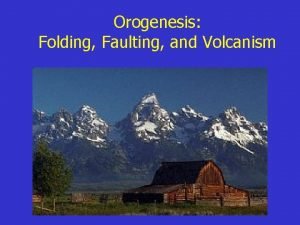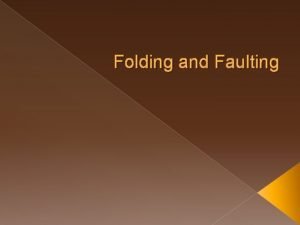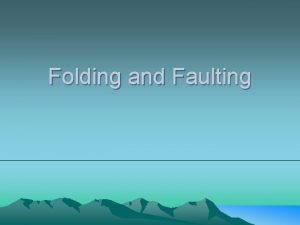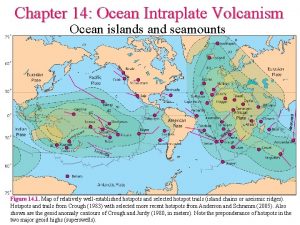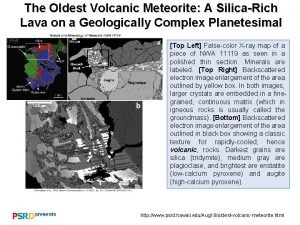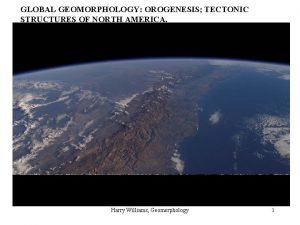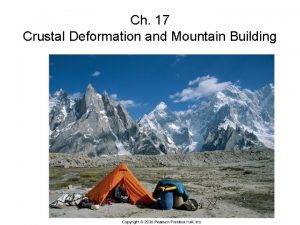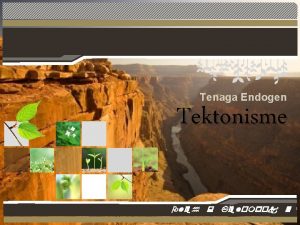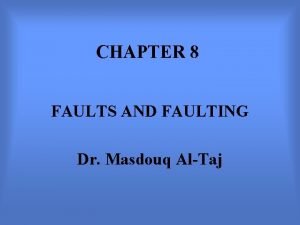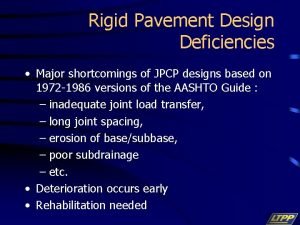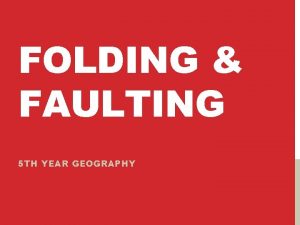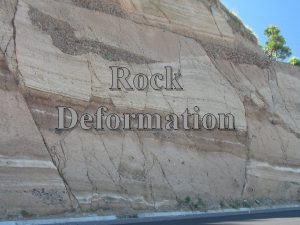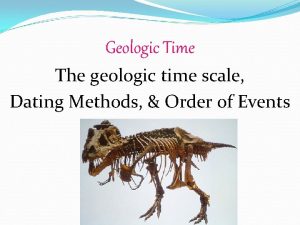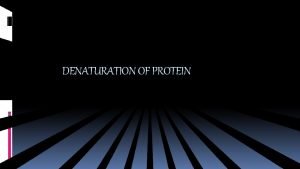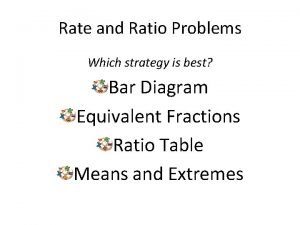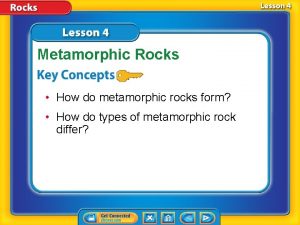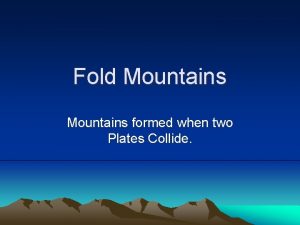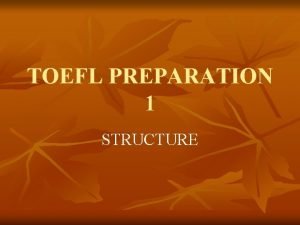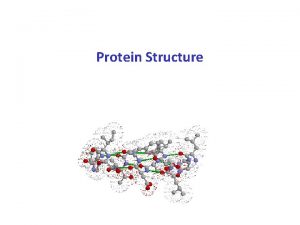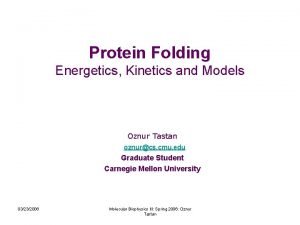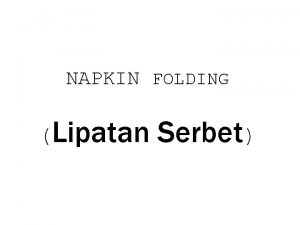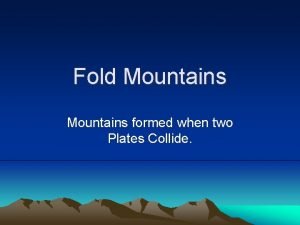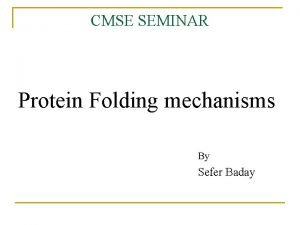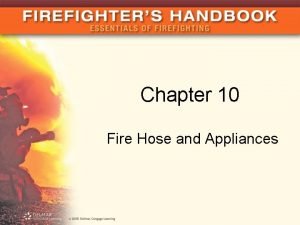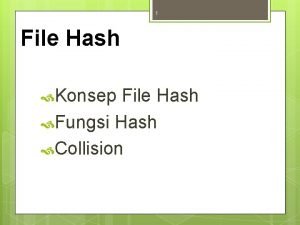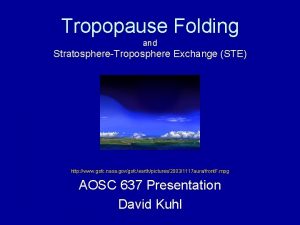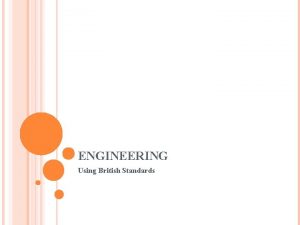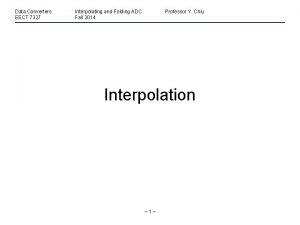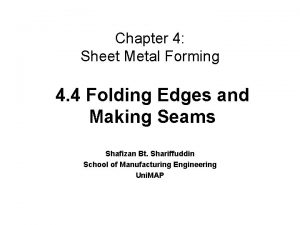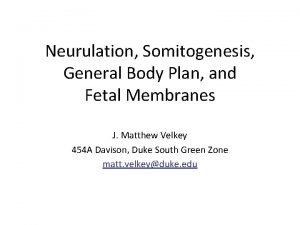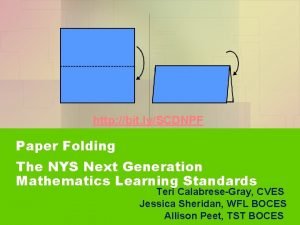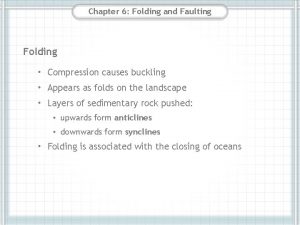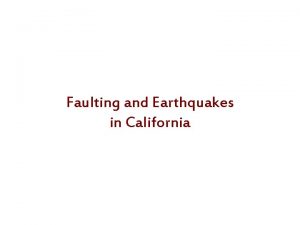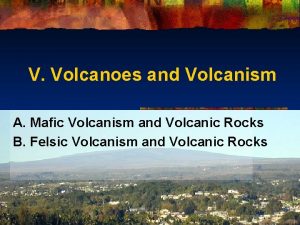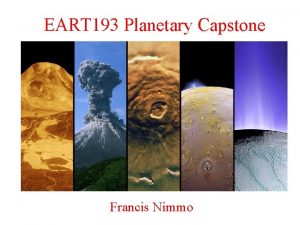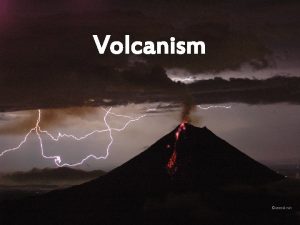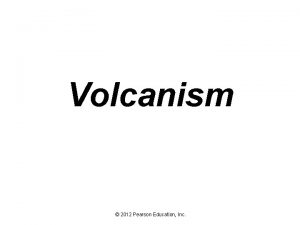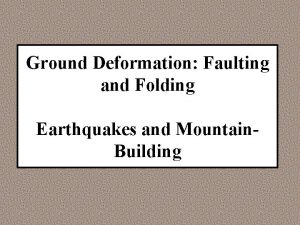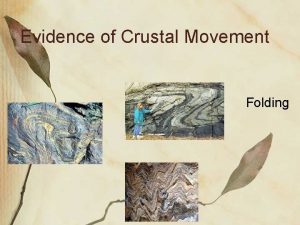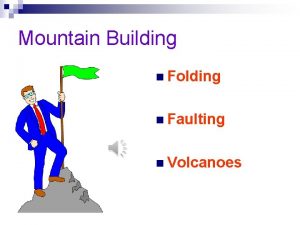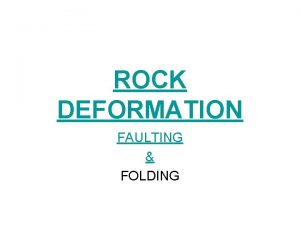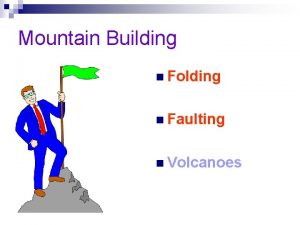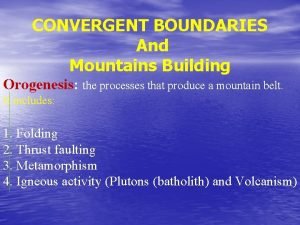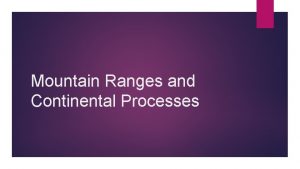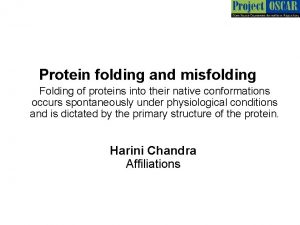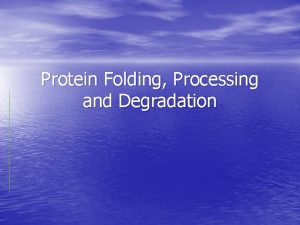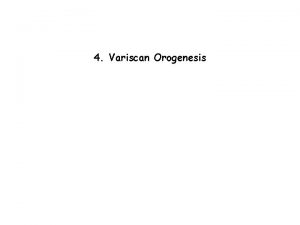Orogenesis Folding Faulting and Volcanism Folding response to












































- Slides: 44

Orogenesis: Folding, Faulting, and Volcanism

Folding • response to compression or shear

Faulting • Definition: fractures where some type of displacement (movement) has occurred. • Three types – normal – reverse/thrust – transform (strike-slip) Carmel Valley Fault, CA


Landforms - Normal Faulting • Fault escarpment Owens Valley, CA Sierra Nevada, CA Grand Tetons, WY

Normal Faulting • Horst and graben (“hill” and “grave”) Death Valley/ Panamint Ranges

Transform (strike-slip) faults

San Andreas fault System – How long is it? About 600 miles (1000 km) – Relative motion of the Pacific Plate? @ 2 inches (5 cm) northwest per year. (We’ll be off the coast of San Francisco in 12 million years!)

Transform Plate Boundary • Features: – shallow, linear rift valleys Carrizo Plain, central CA San Andreas Lake (Crystal Springs Reservoir) - looking south along fault - San Francisco water supply - geology vegetation

Transform Plate Boundary • Activity: – shallow to moderate earthquakes – little to no volcanism Temblor Range Dragon’s Back Carrizo Plain, CA (view to the east)


The Geography of Earthquakes • Globally: primarily at plate boundaries • Intraplate earthquakes do occur!

The Geography of Earthquakes • USA: 1977 -1997 earthquake events • USA: every state except ND, FL

Earthquakes • Earthquakes are the shaking or vibration of the ground as a result of rocks suddenly breaking along a fault. • Focus (hypocenter) = rupture point • Epicenter = point on surface above focus • Foreshocks • Aftershocks

Process: the earthquake cycle (elastic rebound theory) • Earthquakes are a ‘release of energy’ in the form of a seismic wave (vibrates the crust). • Plate movement strain builds rocks “locked together” (frictional bond) • Rocks bend hit limit --> rupture/break • Cycle repeats ”start-stop” motion along fault


Seismic Waves • Some of the waves that are generated by an earthquake travel within the earth and other travel along the surface. • Waves traveling within the earth are known as body waves. • Surface waves cause the most damage to buildings during an earthquake.

Surface Waves • Surface waves can set up liquefaction in alluvium. This is where the most extensive damage to buildings occurs. – Liquefaction: wavelike, almost liquid, rolling of surface – Alluvium: fine material deposited by water over many years.

Measuring Earthquakes • seismograph: records the vibrations of the crust (Richter Scale) • seismogram: tracing record • Modified Mercalli Scale (I-VII) measures damage

Major California Earthquakes • Fort Tejon, 1857 - 8. 0 magnitude • San Francisco, 1906 - 7. 9 magnitude • 1933 Long Beach - 6. 3 magnitude Destroyed Glendale College Buildings! • San Fernando, 1971 - 6. 6 • Northridge, 1994 - 6. 7 • Hector Mine, 1999 - 7. 1

Fort Tejon, 1857 California’s largest ever! • TIME: January 9, 1857 • LOCATION: about 72 km (45 miles) northeast of San Luis Obispo • MAGNITUDE: Mw 8. 0 (approx. ) • TYPE OF FAULTING: right-lateral strike-slip • FAULT RUPTURED: San Andreas fault • LENGTH OF SURFACE RUPTURE: about 360 km (225 miles) • MAXIMUM SURFACE OFFSET: about 9 meters (30 feet)

San Francisco Aftermath, 1906 Magnitude: 7. 9

San Francisco, 1906 Magnitude: 7. 9


Volcanoes and Volcanic Activity

The Geography of Volcanism • Three major zones of volcanic activity – convergent plate boundaries – divergent plate boundaries – hot spots

Volcano Classification • active: has erupted in recorded history. (Kilauea, Hi, Mt. Etna, Italy, Mt. Lassen) • dormant: has not been seen to erupt in history, but shows evidence of recent activity. (Mammoth Mtn, CA or Crater Lake, OR) • extinct: no sign of recent or historic activity (Mt. Kilimanjaro, East Africa)

Volcanoes: Explosive • Composite cones (stratovolcano) – pointed, steep-sided, tall volcanoes – “Composite”: layers of pyroclastics and lava (mostly felsic) – Explosive and dangerous; found in subduction zones

Landforms: Explosive Arenal, Costa Rica



Hot Spots • Isolated columns of hot magma rising slowly within the aesthenosphere (mantle). • Melts overlying crust, “burning a hole through” • Can be underneath continents or ocean plates.

Landforms: Effusive • Shield volcanoes – large, rounded volcanoes with a gentle slope – central vent – flat terrain (or can not build up dome) – constructed by a series of basalt flows over time.


Hot Spot Example: Hawaii


Hot Spots • Loihi – building, but still 1000 m below surface – will eventually replace the Big Island

The Geography of Volcanism • Volcanism primarily submarine. – several thousand volcanoes are continental (about 600 are active) – over 50, 000 in the Pacific ocean alone

(Selected) Major Historic Eruptions • Krakatoa (1883), Indonesia – eruption obliterates an entire group of islands, leaving a submerged caldera. – blast heard for thousands of miles – ash reaches mesosphere (80 km / 50 mi) – tsunami’s kill about 40, 000 people

Mammoth Lakes • part of Long Valley Caldera • Eruption 760, 000 years ago • 500 x more material ejected than Mt. St. Helens!

Mammoth Mtn next? • Active, moving magma at about 3 km depth • 1200 tons of CO 2 per day coming up through the soil tree kills • earthquake swarms • little surface deformation • Classification? dormant

Devil’s Tower National Monument, Wyoming


 Define folding faulting and volcanic activity
Define folding faulting and volcanic activity Type of fold: downfolds or troughs
Type of fold: downfolds or troughs Folding and faulting graphic organizer
Folding and faulting graphic organizer Intraplate volcanism
Intraplate volcanism Volcanism
Volcanism Orogenesis
Orogenesis Plunging syncline vs syncline
Plunging syncline vs syncline Tenaga endogen tektonisme
Tenaga endogen tektonisme Normal fault map symbol
Normal fault map symbol Jpcp pavement design
Jpcp pavement design Anderson theory of faulting
Anderson theory of faulting Faulting
Faulting Faulting in geography
Faulting in geography Faulting in geography
Faulting in geography Stress faults
Stress faults Faulting
Faulting Natural response and forced response
Natural response and forced response Natural response and forced response example
Natural response and forced response example Primary immune response and secondary immune response
Primary immune response and secondary immune response Denaturation and protein folding
Denaturation and protein folding Ms.johnson and ms.siple
Ms.johnson and ms.siple Permanent bending and folding of rocks without melting
Permanent bending and folding of rocks without melting How are fold mountains formed
How are fold mountains formed The drastic decline of the beaver helps to illustrate
The drastic decline of the beaver helps to illustrate Giveq
Giveq Florys models
Florys models Diamond napkin fold
Diamond napkin fold Folding napkin adalah
Folding napkin adalah John purdy inventor
John purdy inventor Pembentukan muka bumi
Pembentukan muka bumi Arm architecture logo
Arm architecture logo Relict mountain
Relict mountain Hydrophobic collapse in protein folding
Hydrophobic collapse in protein folding Types of hose folding
Types of hose folding Folding hash
Folding hash Tropopause fold
Tropopause fold Choi
Choi British standard for folding drawings
British standard for folding drawings Folding adc
Folding adc John robinson lunch box inventor
John robinson lunch box inventor Floral design tools and supplies
Floral design tools and supplies In sheet metal operation two edges are joined by
In sheet metal operation two edges are joined by Spring boot transaction-manager 설정
Spring boot transaction-manager 설정 Paraxial mesoderm
Paraxial mesoderm Bit.ly321
Bit.ly321
